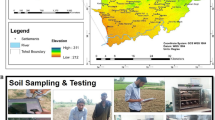Abstract
Ground subsidence in abandoned underground coal mine areas can result in loss of life and property. We analyzed ground subsidence susceptibility (GSS) around abandoned coal mines in Jeong-am, Gangwon-do, South Korea, using artificial neural network (ANN) and geographic information system approaches. Spatial data of subsidence area, topography, and geology, as well as various ground-engineering data, were collected and used to create a raster database of relevant factors for a GSS map. Eight major factors causing ground subsidence were extracted from the existing ground subsidence area: slope, depth of coal mine, distance from pit, groundwater depth, rock-mass rating, distance from fault, geology, and land use. Areas of ground subsidence were randomly divided into a training set to analyze GSS using the ANN and a test set to validate the predicted GSS map. Weights of each factor’s relative importance were determined by the back-propagation training algorithms and applied to the input factor. The GSS was then calculated using the weights, and GSS maps were created. The process was repeated ten times to check the stability of analysis model using a different training data set. The map was validated using area-under-the-curve analysis with the ground subsidence areas that had not been used to train the model. The validation showed prediction accuracies between 94.84 and 95.98%, representing overall satisfactory agreement. Among the input factors, “distance from fault” had the highest average weight (i.e., 1.5477), indicating that this factor was most important. The generated maps can be used to estimate hazards to people, property, and existing infrastructure, such as the transportation network, and as part of land-use and infrastructure planning.








Similar content being viewed by others
References
Adinarayana J, Krishna NR (1996) Integration of multi-seasonal remotely-sensed images for improved landuse classification of a hilly watershed using geographical information systems. International Journal of Remote Sensing 17:1679–1688
Ambrožič T, Turk G (2003) Prediction of subsidence due to underground mining by artificial neural networks. Computers & Geosciences 29(5):627–637
Atkinson PM, Tatnall ARL (1997) Neural networks in remote sensing. International Journal of Remote Sensing 18:699–709
Bieniawski ZT (1989) Engineering rock mass classifications: a complete manual for engineers and geologists in mining, civil, and petroleum engineering. Wiley-Interscience, London, pp 40–47
Choi JK, Kim KD, Lee S, Won JS (2010) Application of a fuzzy operator to susceptibility estimations of coal mine subsidence in Taebaek City, Korea. Environmental Earth Science 59(5):1009–1022
Coal Industry Promotion Board (1997) A study on the mechanism of subsidence over abandoned mine area and the Construction method of subsidence prevention. Coal Industry Promotion Board, Seoul, pp 97–106
Esaki T, Djamaluddin I, Mitani Y (2008) A GIS-based prediction method to evaluate subsidence-induced damage from coal mining beneath a reservoir, Kyushu, Japan. Quarterly Journal of Engineering Geology and Hydrogeology 41(3):381–392
Garrett JH (1994) Where and why artificial neural networks are applicable in civil engineering. Journal of Computing in Civil Engineering 8(2):129–130
Geological Society of Korea (1999) The geology of Korea. Sigma Press, Seoul, p 802
Hines JW (1997) Fuzzy and neural approaches in engineering. Wiley, New York, p 209
Kim KD, Lee S, Oh HJ, Choi JK, Won JS (2006) Assessment of ground subsidence hazard near an abandoned underground coal mine using GIS. Environmental Geology 50(8):1183–1191
Kim KD, Lee S, Oh HJ (2009) Prediction of ground subsidence in Samcheok City, Korea using artificial neural networks and GIS. Environmental Geology 58(1):61–70
Kwon K, Yu MH, Park HD (2000) A study on the application of GIS for analysis of subsidence hazard. Economic and Environmental Geology 33(6):557–563
Lee S, Dan NT (2005) Probabilistic landslide susceptibility mapping in the Lai Chau province of Vietnam: focus on the relationship between tectonic fractures and landslides. Environmental Geology 48:778–787
Lee S, Oh HJ, Kim KD (2010) Statistical spatial modeling of ground subsidence hazard near an abandoned underground coal mine. Disaster Advances 3(1):11–23
Mancini F, Stecchi F, Gabbianelli G (2009) GIS-based assessment of risk due to salt mining activities at Tuzla (Bosnia and Herzegovina). Engineering Geology 109(3–4):170–182
Mine Reclamation Corporation (2007). http://www.mireco.or.kr. Accessed 10 August 2007
Ministry of Knowledge Economy (2007) Available at: http://www.mocie.go.kr. Accessed 16 July 2007
Oh HJ, Lee S (2010) Assessment of ground subsidence using GIS and the weights-of-evidence model. Engineering Geology 115:26–48
Oh HJ, Lee S (2011) Integration of ground subsidence hazard maps of abandoned coal mines in Samcheok, Korea. International Journal of Coal Geology 86(1):58–72
Oh HJ, Ahn SC, Choi JK, Lee S (2011) Sensitivity analysis for the GIS-based mapping of the ground subsidence hazard near abandoned underground coal mines. Environmental Earth Science 64:347–358
Paola JD, Schowengerdt RA (1995) A review and analysis of backpropagation neural networks for classification of remotely sensed multi-spectral imagery. International Journal of Remote Sensing 16:3033–3058
Quanyuan W, Jiewu P, Shanzhong Q, Yiping L, Congcong H, Tingxiang L et al (2009) Impacts of coal mining subsidence on the surface landscape in Longkou city, Shandong Province of China. Environmental Earth Science 59(4):783–791
Turer D, Nefeslioglu HA, Zorlu K, Gokceoglu C (2008) Assessment of geo-environmental problems of the Zonguldak province (NW Turkey). Environmental Geology 55(5):1001–1014
Waltham AC (1989) Ground subsidence. Blackie & Son Ltd, New York, pp 49–97
Zahiri H, Palamara DR, Flentje P, Brassington GM, Baafi E (2006) A GIS-based weights-of-evidence model for mapping cliff instabilities associated with mine subsidence. Environmental Geology 51(3):377–386
Zhou W (1999) Verification of the nonparametric characteristics of backpropagation neural networks for image classification. IEEE Transactions on Geoscience and Remote Sensing 37(2):771–779
Acknowledgments
The authors thank the Coal Industry Promotion Board for providing entire investigation reports and the basic GIS database. This research was supported by the Basic Research Project of the Korea Institute of Geoscience and Mineral Resources funded by the Ministry of Knowledge and Economy of Korea.
Author information
Authors and Affiliations
Corresponding author
Rights and permissions
About this article
Cite this article
Lee, S., Park, I. & Choi, JK. Spatial Prediction of Ground Subsidence Susceptibility Using an Artificial Neural Network. Environmental Management 49, 347–358 (2012). https://doi.org/10.1007/s00267-011-9766-5
Received:
Accepted:
Published:
Issue Date:
DOI: https://doi.org/10.1007/s00267-011-9766-5




